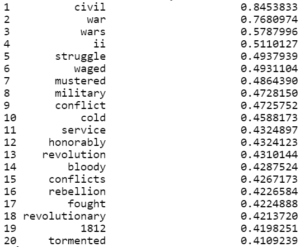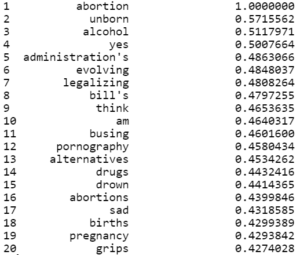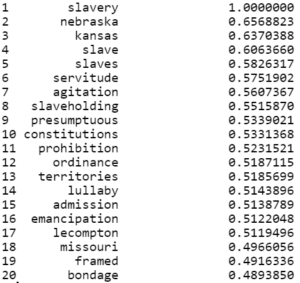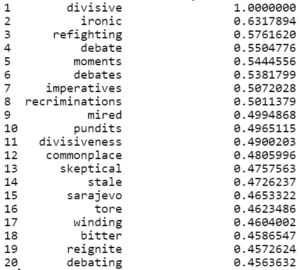By Emily Hontoria
Introduction
In this era of everything from the Women's March[1] to calls to put up a border wall[2], the current political climate in the United States can be most accurately described as divisive. As a millennial myself, I cannot remember a time in political history that has been so full of conflicting opinions and debate. This got me thinking: what have been the most divisive topics in American history? It turns out this question comes with a whole host of challenges, not the least of which are defining what divisive means, and how one measures divisiveness. After exploring the literature around the social implications of divisive topics[3], the semiotics of public and private opinion and how that shapes our understanding of divisive topics over time[4], and new ways of determining the sentiment surrounding social issues[5]; I've come to the conclusion that while divisiveness can be subjective, there is an objective component to it. I chose presidential speeches as my corpus, gleaned from the Miller Center in Virginia[6] from the first 44 presidents: George Washington through Barack Obama. I cleaned my data to remove meta data tags about dates and the title of the speeches, as well as stop words such as a, with, and the using nltk's stop-word library and tools in python3[7].
Nature of Divisiveness
What does it mean for a topic to be divisive, and how can one tell? The basic idea when I first looked into this topic was built off divisive primaries, and how by measuring how close the political polling was, would categorize a particular primary as divisive or not. However, for my work this wasn't particularly useful without any sort of statistical backing of a mass number. Rather, I was more interested in what sort of language or trends can be seen across many divisive topics, such that I could better recognize a topic as such.
Implicit in the above discussion is a definition of divisiveness in terms of perceived distribution of social opinion...A topic is maximally divisive when it splits society into two equal opinion groups.[1]
Defining Divisive Topics
Coming in with my own assumptions and understanding of what a divisive topic is, some of my preliminary queries were to look at the similarities between the word2vec queries of V(civil)+V(war) and V(abortion) and V(slavery). I chose these three because of their individual divisiveness, to see if there was anything that jumped out as close to any two or three of these topics. Firstly, civil war is what I would determine as a divisive object, fighting between people of a nation - I was interested in what sort of topics came up around it. Secondly, abortion has been a divisive topic across United States history with supreme court rulings around abortion still under question and marches for pro-life and pro-choice still happening around the country. Thirdly, slavery was the main cause of the American Civil War, which made me interested in what kind of emotions were there.



Pivot to Divisive Ideas
Having looked at Figures 1 through 3 and not found much similarity, I decided to pivot and instead look at the neighborhood of divisive.

It was interesting that it relates to things like moments, stale, and ironic. I looked a little deeper at ironic because it seemed like an interesting relation. Having looked at specific instances where ironic shows up, it does indeed show up in the neighborhood of divisiveness, and comes up close to topics like affirmative action and the deficit which I would call divisive topics. I would say that the idea of things parallel to the vector V(divisive)+V(ironic) may be interesting, which is what I looked at next. The question though becomes if this is how we pin down the neighborhood of divisiveness, what can we do with this?
Shortcomings and Ideas for Further Research
I was at first discouraged by A Semiotics of Private and Public Distinction put forth by Susan Gal as she spoke about the fractal nature of public and private discourse, how it changes over time, and it's impact to our understanding of social issues[4, pg. 79]. It brings to light a central flaw in my analysis: the fact that what people understand as divisive changes over time. For example, slavery in the American Civil War era was a deeply divisive topic, whereas nowadays it is not seen that way. In the future who knows, when people look back perhaps abortion or immigration will no longer be divisive topics.
If I were to continue this research though, I would further explore the idea of how irony and divisive can be used to better answer the question of what topics are actually divisive. Although I didn't get a concrete answer to my question, I feel like I got closer to it and found some interesting relationships along the way.
Bibliography
[1] - Women’s March Highlights as Huge Crowds Protest Trump: ‘We’re Not Going Away’, By ANEMONA HARTOCOLLIS and YAMICHE ALCINDOR, https://www.nytimes.com/2017/01/21/us/womens-march.html, January 21, 2017
[2] - https://www.usatoday.com/border-wall/
[3] - Communication Research; 2018, Vol. 45(2) 165–187; © The Author(s) 2016; Reprints and permissions:
sagepub.com/journalsPermissions.nav; DOI: 10.1177/0093650216644025; journals.sagepub.com/home/crx; Divisive Topics as Social Threats; Joseph J. P. Simons and Melanie C. Green
[4] - A Semiotics of the Public/Private Distinction; differences: A Journal of Feminist Cultural Studies, Volume 13, Number 1, Spring 2002, pp. 77-95 (Article); Susan Gal
[5] - Sentiment Analysis of Social Issues; Mostafa Karamibekr and Ali A. Ghorbani; December 2012
[6] - https://millercenter.org/the-presidency/presidential-speeches; Miller Center Virginia
[7] - https://pythonprogramming.net/stop-words-nltk-tutorial/